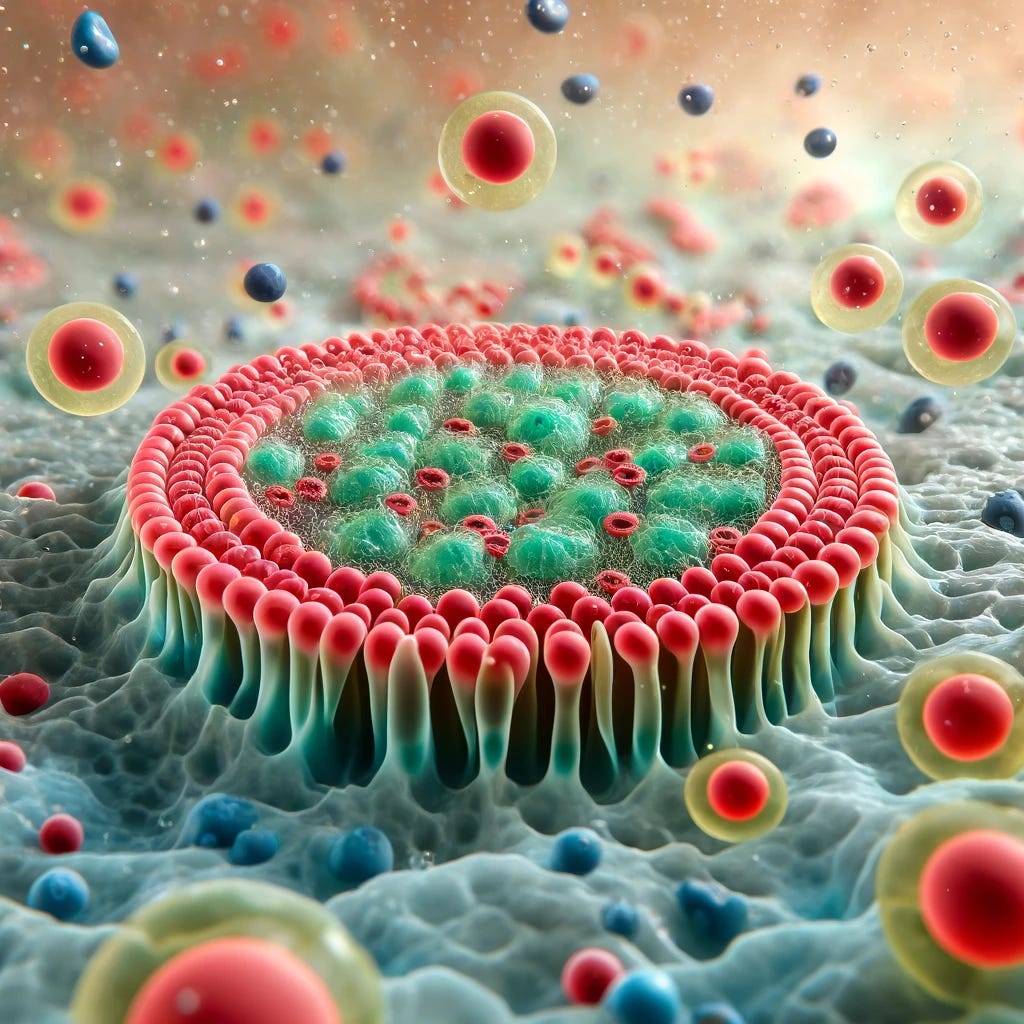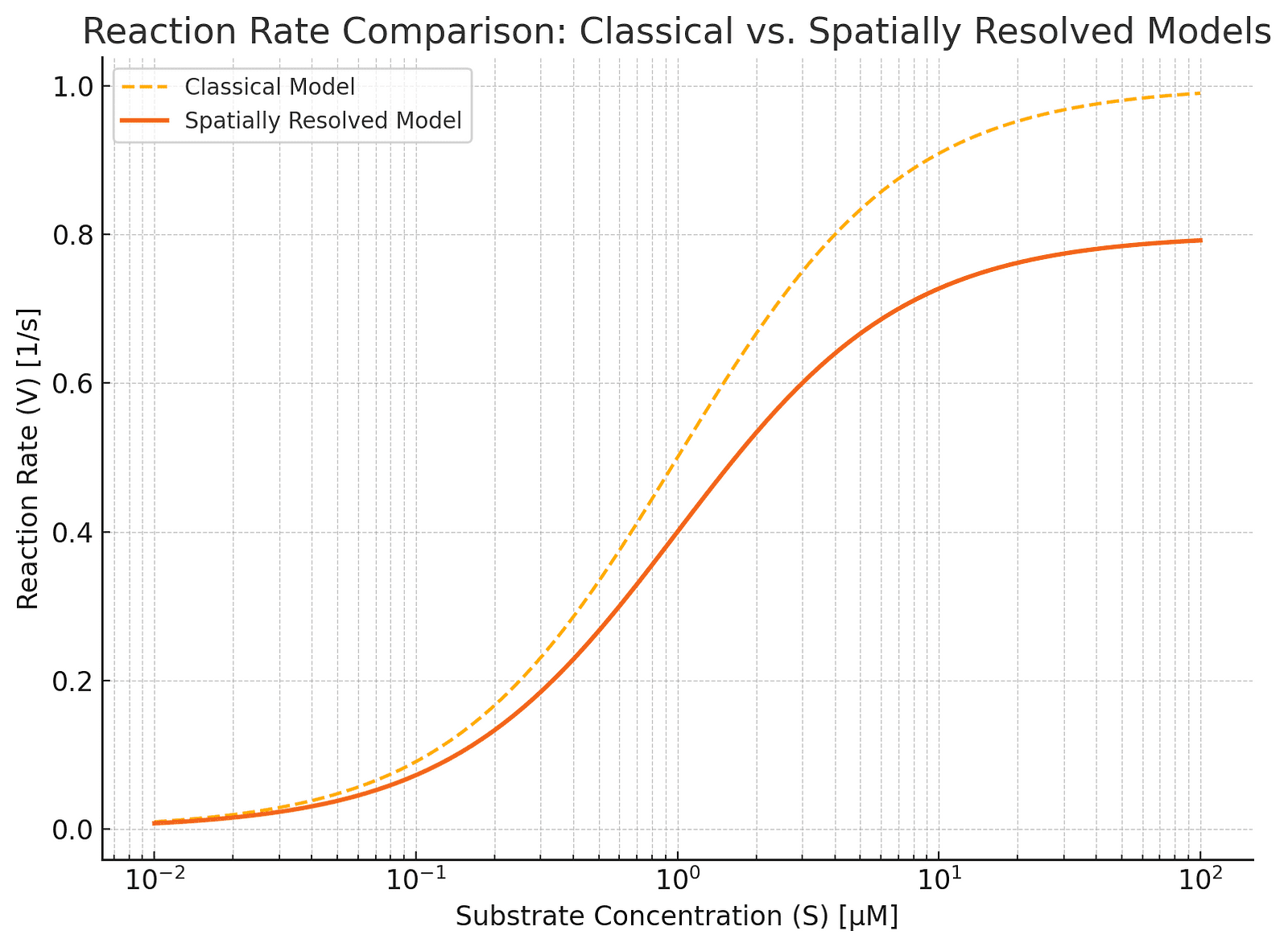What if classical enzyme theories are misleading for cell membrane receptors?

In the microscopic world of cellular biology, the dance between molecules and membrane-bound receptors orchestrates life’s most intricate symphonies. From neurotransmitters sparking neural communication to bacterial receptors breaking down pollutants, these molecular interactions are pivotal. But what if our understanding of these reactions is fundamentally flawed? Classical theories like Michaelis-Menten kinetics assume a “well-mixed” environment, neglecting the spatial intricacies of membrane receptors. Recent research reveals that the geometry and spatial arrangement of receptors profoundly influence reaction rates, especially in crowded cellular landscapes. The implications are staggering: by revising classical models to include spatial dynamics, we might redefine our understanding of cellular processes and drug design.
Revisiting Michaelis-Menten Kinetics
Why the Classics Fall Short: Michaelis-Menten on Membranes
Michaelis-Menten kinetics have long been a cornerstone of biochemistry. The model, first developed in 1913, describes how substrates bind to enzymes, forming complexes that convert into products. It assumes a homogeneously mixed environment where substrates have equal chances of interacting with enzymes. However, in the cellular world, enzymes are often embedded in two-dimensional membranes, creating spatial constraints and competition.
Imagine a bustling city. The classical model assumes every resident (substrate) has equal access to every shop (receptor). But in reality, shops are clustered, and residents compete based on proximity and crowding. This analogy captures the essence of receptor competition on cell membranes. Research shows that classical models overestimate reaction rates when receptors cluster on a surface. For example, high substrate concentrations mask the effects of spatial competition, leading to inaccurate predictions. This insight demands a shift: incorporating spatial parameters into kinetic models to account for real-world cellular conditions.
The Impact of Spatial Competition
How Spatial Competition Changes Everything in Biochemistry
Spatial competition transforms how molecules interact with receptors. When receptors are confined to a two-dimensional membrane, proximity matters. Molecules arriving at a membrane encounter clusters of receptors, creating zones of intense competition. This clustering not only slows reaction rates but alters the fundamental dynamics of molecule-receptor interactions.
Consider the example of bacterial nutrient uptake. Bacterial cell membranes are dotted with receptors, each vying for diffusing nutrient molecules. Classical models predict a linear relationship between substrate concentration and uptake rates. But spatially resolved models reveal non-linear patterns, especially under low substrate concentrations. A key factor here is the “trapping rate,” which depends on receptor density and their geometric arrangement. When receptors cluster densely, molecules are “trapped” more effectively, leading to prolonged interaction times but reduced efficiency.
To illustrate, we present the following graph showing the difference between reaction rates predicted by classical and spatially resolved models under varying substrate concentrations.

Practical Implications for Drug Design
Redesigning Drugs: Lessons from Membrane Kinetics
The revelation of spatial effects in membrane kinetics has profound implications for drug development. Many drugs target membrane receptors, from statins to antiretrovirals. Classical models have guided drug design for decades, but they overlook the spatial nuances that dictate receptor behavior in vivo.
Take competitive inhibitors, for instance. These molecules block receptor active sites, preventing substrates from binding. Spatial models show that the effectiveness of such inhibitors depends not just on their concentration but also on their distribution relative to receptors. Drugs designed without considering receptor clustering might work well in vitro but fail in vivo due to unforeseen spatial effects.
Similarly, uncompetitive inhibitors, which bind only to receptor-substrate complexes, exhibit surprising dynamics in spatially constrained environments. Their efficacy can vary drastically based on receptor density and substrate concentration. By integrating spatial parameters into computational models, drug developers can simulate more realistic scenarios, potentially reducing costly trial-and-error phases.
The Limits of Classical Assumptions
Classical Michaelis-Menten kinetics assume evenly distributed receptors in three dimensions. On real cell membranes, receptors are confined to two dimensions, creating competitive bottlenecks.
Spatial Competition in Action
In dense bacterial colonies, substrate uptake rates are 30% lower than classical predictions due to receptor clustering and competition.
Insights from Drug Mechanisms
Statins, which inhibit cholesterol synthesis, interact with membrane receptors differently when spatial dynamics are considered, affecting their dosage efficacy.
Uncovering Uncompetitive Inhibition
Uncompetitive inhibitors, like Alzheimer’s drug memantine, behave unpredictably under spatial constraints, highlighting the need for revised therapeutic models.
A New Metric: Trapping Rates
Spatial models introduce the “trapping rate,” a measure of receptor efficiency based on density and arrangement, redefining how we quantify reaction dynamics.
From Chaos to Clarity: Embracing Spatial Models in Biochemistry
As we peer deeper into the molecular world, it becomes evident that spatial constraints shape cellular processes in ways classical models cannot predict. By integrating spatial parameters into reaction kinetics, we unlock a more nuanced understanding of biology, from bacterial nutrient uptake to drug-receptor interactions. This shift is not merely academic; it has the potential to revolutionize drug design, precision medicine, and our grasp of life’s fundamental processes. In the labyrinth of cellular membranes, spatial dynamics guide the path — and we are only beginning to decode their secrets.
About Disruptive Concepts
Welcome to @Disruptive Concepts — your crystal ball into the future of technology. 🚀 Subscribe for new insight videos every Saturday!
See us on https://twitter.com/DisruptConcept
Read us on https://medium.com/@disruptiveconcepts
Enjoy us at https://disruptive-concepts.com
Whitepapers for you at: https://disruptiveconcepts.gumroad.com/l/emjml
New Apps: https://2025disruptive.netlify.app/







